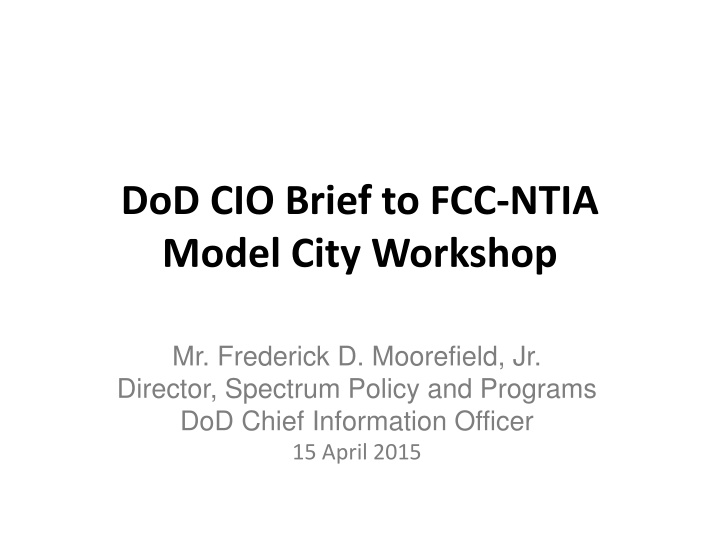
Innovative Spectrum Technologies in DoD Spectrum Access Research
Discover how the Department of Defense is advancing spectrum access through innovative technologies, collaboration with industry, and a focus on EMS efficiency and resilience. Learn about the National Spectrum Consortium and the ongoing Spectrum Access Research and Development Program to improve electromagnetic spectrum utilization.
Download Presentation

Please find below an Image/Link to download the presentation.
The content on the website is provided AS IS for your information and personal use only. It may not be sold, licensed, or shared on other websites without obtaining consent from the author. If you encounter any issues during the download, it is possible that the publisher has removed the file from their server.
You are allowed to download the files provided on this website for personal or commercial use, subject to the condition that they are used lawfully. All files are the property of their respective owners.
The content on the website is provided AS IS for your information and personal use only. It may not be sold, licensed, or shared on other websites without obtaining consent from the author.
E N D
Presentation Transcript
DoD CIO Brief to FCC-NTIA Model City Workshop Mr. Frederick D. Moorefield, Jr. Director, Spectrum Policy and Programs DoD Chief Information Officer 15 April 2015
Overview The objective of the Spectrum Access Research and Development Program is the development and implementation of innovative spectrum technologies Leverages the ongoing DoD EMS Strategy activities focusing on EMS efficiency, flexibility and adaptability to improve spectrum access EMS agility to move to available spectrum bands EMS resilience to operate in congested and contested spectrum environments Current focus is on reducing the risks associated with the implementation of DoD s AWS-3 transition, EMS congestion and EMS contention April 3rdDoD entered into an Other Transaction Agreement (OTA) with the National Spectrum Consortium (NSC) The mission of the NSC is to foster collaboration between government and industry to identify, develop, and demonstrate the enabling technologies necessary to broaden the military and commercial access to and use of the electromagnetic spectrum NSC currently has 115 committed organizations Further information about the National Spectrum Consortium is available at http://www.nationalspectrumconsortium.com/ Purpose of the OTA is to bring spectrum access improvement through collaboration with industry faster to meet rapidly evolving requirements 2
Approach Conditions for Success must be created: Program Strategy & Plan underpinning investment portfolio Technology must be matured Technology performance demonstrated Experimentation to leverage the technology more effectively Trust in reliability, availability, non-interference, and protection of stakeholder equities Policy environment conducive to technology utilization Ability to transition to PORs to field restored/enhanced operational capability via existing or additional SRF funding Technology Prototype Development, Demo Assessment Architecture Policy Scope: Command & Control Communications Sensors Electronic Warfare Training Assessment in Complex Environment Experimentation Requirements CONOPS,TTPs 3
EMS S&T and R&D Focus: Initial Sharing Technologies Spectrum Access Architecture Multiple Input, Multiple Output (MIMO) Dynamic Spectrum Access (DSA) & Frequency Reuse (FR) Technologies Modeling & Simulation of the Electromagnetic Environment (EME) Air/Maritime Training Instrumentation (AMTI) Waveform Radar & commercial- communications sharing technology Interference Tolerance & Hardening Technologies Adaptive RF Technologies Millimeterwave & Frees Space Optical technologies Spectrum Situational Awareness (SA), Spectrum Command & Control (C2) & Mgt. of the Electromagnetic Environment (EM) 4
